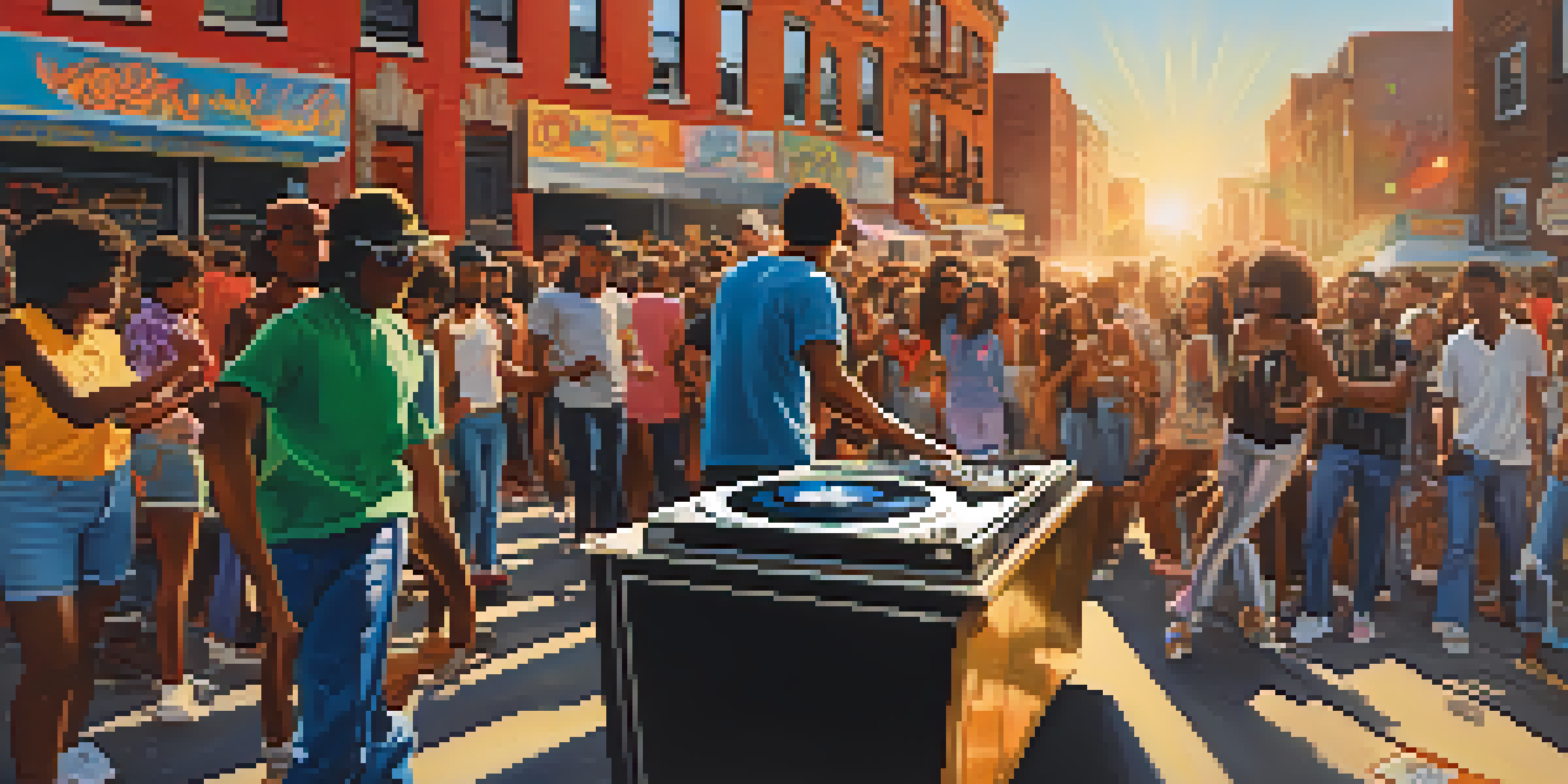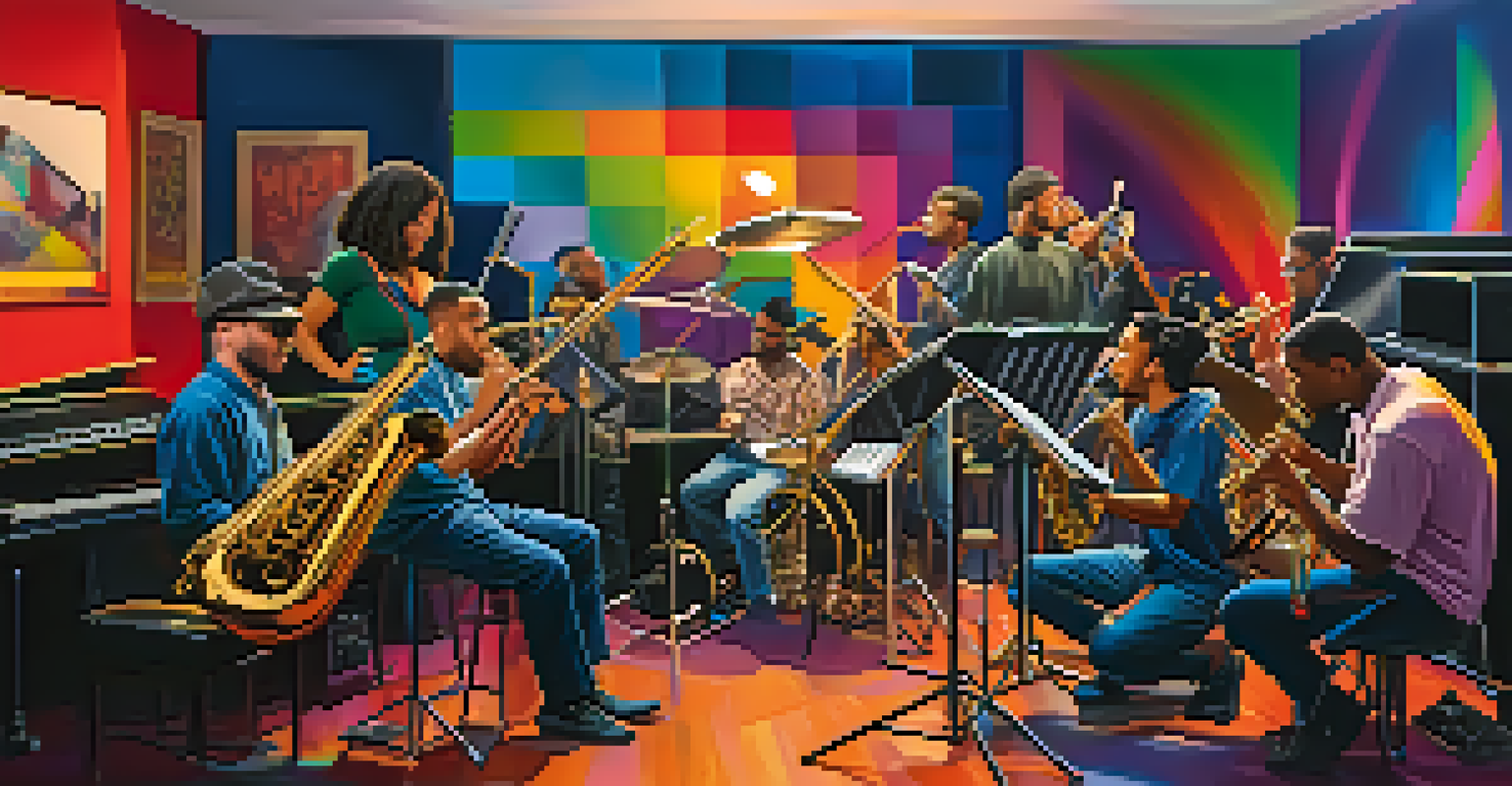Jazz and Hip-Hop: A Rhythmical Journey Through Time

The Origins of Jazz: A Melodic Revolution
Jazz emerged in the early 20th century, primarily in New Orleans, as a blend of African and European musical traditions. This new genre was characterized by its improvisational style, syncopated rhythms, and expressive melodies that captivated audiences. Artists like Louis Armstrong and Duke Ellington paved the way, introducing a fresh sound that was both innovative and deeply rooted in cultural heritage.
Jazz is the only music in which the same note can be played night after night but differently each time.
As jazz spread across the United States, it evolved into various subgenres, including bebop, cool jazz, and free jazz. Each style brought its own flavor, showcasing the incredible versatility of jazz musicians. This evolution laid the groundwork for future genres, including hip-hop, by highlighting the importance of rhythm and improvisation in music.
The cultural significance of jazz cannot be overstated. It served as a voice for African Americans during the Civil Rights Movement, expressing struggles and triumphs through powerful melodies. This legacy of storytelling and emotional depth continues to resonate in contemporary music, making jazz a vital part of the musical tapestry.
The Birth of Hip-Hop: A Cultural Movement
Hip-hop emerged in the 1970s in the Bronx, New York City, as a vibrant cultural movement encompassing music, dance, and art. DJs began experimenting with breakbeats, looping sections of songs to create a rhythmic foundation for MCs to rap over. This innovative approach turned hip-hop into a powerful medium for expression, particularly for marginalized communities.

The early pioneers, such as DJ Kool Herc and Grandmaster Flash, laid the groundwork by incorporating elements from various genres, including funk, soul, and, notably, jazz. This blending of styles allowed hip-hop to develop its unique sound while drawing inspiration from the rich musical traditions that came before it. The incorporation of jazz samples became a hallmark of hip-hop production.
Jazz Laid the Foundation for Hip-Hop
Jazz's improvisational style and rich cultural heritage significantly influenced the development of hip-hop music.
As hip-hop gained popularity, it transcended genres and became a global phenomenon. The storytelling aspect of rap mirrored the narrative quality of jazz, creating a connection between the two genres that continues to this day. Hip-hop artists often pay homage to their jazz predecessors, showcasing the timeless influence of jazz on modern music.
Jazz Influence on Hip-Hop: A Harmonious Blend
The relationship between jazz and hip-hop is deeply intertwined, with hip-hop artists frequently sampling jazz tracks to create their beats. This practice not only pays tribute to the jazz genre but also enhances the texture and depth of hip-hop music. The smooth, intricate melodies of jazz provide a rich backdrop for the rhythmic flow of rap, creating a unique fusion that resonates with listeners.
Hip-hop is a way for me to express myself, and I think that's true for a lot of people. It's about storytelling and sharing experiences.
Notable hip-hop artists like A Tribe Called Quest and Gang Starr have successfully integrated jazz samples into their music, producing iconic tracks that showcase this collaboration. These artists skillfully blend live instrumentation and sampling, allowing jazz's improvisational spirit to shine through. This cross-pollination has led to some of the most memorable moments in hip-hop history.
Moreover, jazz musicians have begun to embrace hip-hop as a modern extension of their art. Collaborations between artists from both genres, such as those between Robert Glasper and Common, demonstrate how jazz can evolve while retaining its core elements. This ongoing dialogue between jazz and hip-hop enriches both genres, ensuring that their legacies continue to thrive.
The Role of Sampling in Music: An Artistic Technique
Sampling, the practice of taking a portion of a sound recording and reusing it in a different song, has become a fundamental technique in hip-hop production. This method allows artists to pay homage to their musical influences while crafting something entirely new. By sampling jazz, hip-hop producers can infuse their tracks with a sense of history and cultural significance.
The art of sampling is not without its controversies, as debates about copyright and originality continue to surface. However, many argue that sampling is a form of artistic expression that fosters creativity and innovation. By recontextualizing existing music, artists can create a dialogue between past and present, allowing listeners to appreciate the connections between different genres.
Sampling Bridges Musical Genres
The practice of sampling jazz in hip-hop not only honors its roots but also creates a unique fusion that enhances both genres.
As technology has advanced, the world of sampling has expanded, enabling artists to explore a broader range of sounds and styles. This evolution has made it easier for hip-hop artists to incorporate jazz elements, further blurring the lines between the two genres. The result is a rich sonic landscape that reflects the diverse musical influences that shape our contemporary sound.
Contemporary Jazz-Hip-Hop Collaborations: A New Era
In recent years, the collaboration between jazz and hip-hop artists has reached new heights, with many contemporary musicians pushing the boundaries of both genres. Projects like the 'R+R=Now' collective, featuring artists like Christian Scott and Terrace Martin, showcase the seamless integration of jazz improvisation with hip-hop beats. This fusion not only revitalizes jazz but also introduces hip-hop to new audiences.
These collaborations often explore themes of social justice, identity, and personal experiences, echoing the narrative traditions of both genres. By merging their unique styles, artists create a powerful platform for dialogue and expression, reflecting the complexities of modern life. This creative synergy demonstrates the timeless relevance of jazz and hip-hop in addressing societal issues.
Moreover, festivals and events celebrating this fusion have gained popularity, allowing fans to experience the dynamic interplay between jazz and hip-hop live. These performances often feature spontaneous improvisation, a hallmark of jazz, that keeps audiences engaged and entertained. As artists continue to explore this intersection, the future of jazz and hip-hop looks bright and full of potential.
The Cultural Impact of Jazz and Hip-Hop: A Shared Legacy
Both jazz and hip-hop have transcended their musical roots to become significant cultural movements. They have influenced fashion, language, and social attitudes, shaping the identity of generations. Their ability to convey emotions and tell stories has resonated with listeners, making them powerful tools for social commentary and change.
Jazz, with its rich history of overcoming adversity and breaking barriers, has inspired countless artists across genres. Similarly, hip-hop has emerged as a voice for the voiceless, often addressing issues of inequality and injustice. Together, they represent a shared legacy of resilience and creativity that continues to inspire new generations of musicians and listeners alike.
Collaborations Revitalize Both Genres
Contemporary collaborations between jazz and hip-hop artists showcase the seamless integration of styles, pushing the boundaries of musical expression.
As we look to the future, the ongoing dialogue between jazz and hip-hop will undoubtedly produce fresh interpretations and innovative sounds. By celebrating their shared histories and cultural significance, we can appreciate the profound impact these genres have on music and society. The rhythmical journey through time is far from over, and both jazz and hip-hop will continue to evolve and inspire.
Conclusion: A Continuous Rhythmical Journey
In conclusion, the connection between jazz and hip-hop is a testament to the power of music as a unifying force. Through their shared history, both genres have influenced and enriched each other, creating a unique musical landscape that continues to evolve. As artists from both worlds collaborate and innovate, they keep the spirit of jazz alive while pushing the boundaries of hip-hop.
This rhythmic journey through time highlights the importance of cultural exchange in the world of music. By embracing the richness of their influences, artists can create work that resonates deeply with audiences, fostering a sense of community and understanding. The collaboration between these genres not only honors their past but also paves the way for future generations of musicians.

Ultimately, the legacy of jazz and hip-hop serves as a reminder of the importance of creativity and expression in our lives. As we continue to experience the fusion of these two powerful genres, we celebrate the shared rhythms that connect us all, transcending barriers and uniting us through the universal language of music.